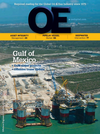
Page 26: of Offshore Engineer Magazine (Oct/Nov 2013)
Read this page in Pdf, Flash or Html5 edition of Oct/Nov 2013 Offshore Engineer Magazine
Asset Integrity
Asset integrity – a global perspective greater awareness of higher assessed
Atkins’ looks at offshore asset Ramsay Fraser probability for wave-in-deck loads during extreme storms and apprecia- integrity assessment techniques and how tion of the implications of these higher probabilities.
acceptance criteria depend on geographic region.
While the assessed loads typically increase due to the above, the latest valuation of the integrity of an older assets, to ensure that degradation computer simulation techniques (such offshore structure is one of the due to fatigue, corrosion, and seabed as ultimate strength analysis using 1 four key functions of an integ- settlement from reservoir compaction software such as ABAQUS with the
E rity management system – the others is acceptable. critical components of the structure being acquisition and management of Development projects on fxed represented in detail and embedded data; strategy for in-service inspection, installations typically involve a sig- within the model of the total structure mitigation and/or early decommis- nifcant increase in topside weight due (in order to provide the correct bound- sioning; and program for in-service to new process facilities together with ary conditions) usually demonstrate inspection. increased wave load due to new risers that the structure has greater capacity
Evaluation requires assessment if an or conductors. than shown using previously adopted initiator is triggered, such as develop- The quantity of metocean data and techniques. 2 ment projects on existing installations, quality of data processing and model- The ISO and API standards for when new metocean or geotechnical ling has increased signifcantly in some offshore structures are currently being information becomes available and, for geographic regions and has resulted in updated and one of the outcomes is likely to be greater consistency in the assessment methodology and criteria
Hazard Curves
Gulf of Suez required for the integrity of offshore 2.40 structures in all regions of the globe.
Recent assessments of fxed offshore 2.20 structures by Atkins in the North Sea,
Gulf of Mexico, Arabian Gulf, Caspian 2.00
Sea, and NW Shelf have indicated that to achieve greater consistency: 1.80 (1.79) 1) The industry needs to set accep- 1.60 tance criteria based on reliability (1.56) studies, structural performance around 1.40 the globe and experience. The criteria 100 year base shear need to be straightforward and limited
Base shear normalized by 1.20 to linear and non-linear methods of analyses and software. Good guidance 1.00 100 1000 10,000 100,000 is required in the codes to allow most
Pf=3E-5
Return period = 1/Pf engineering contractors to do good
Max haz curve COVr=5% & COVw=8% RSRmean work. This guidance should focus
Hazard curve for COVr=15% & COVw=8% Hazard curve for COVr=5% & COVw=8% on the structural modelling; loading
RSRmean Max haz curve COVr=15% & COVw=8% model and material behavior in com-
Min haz curve COVr=0% & COVw=0% Max haz curve COVr=0% & COVw=0% ponent design versus system ultimate
Latest computer simulation techniques reveal the local failure mechanisms of an capacity checks.
ofshore structure when loads exceed the allowable levels.
OE | October 2013 oedigital.com 28 028_OE1013_Asset-3-Atkins.indd 28 9/30/13 1:26 PM

 25
25

 27
27